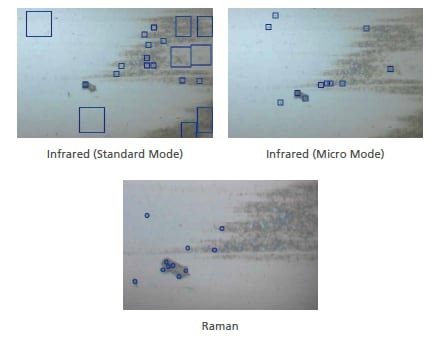AIRsight™ - Features
Infrared/Raman Microscope
Both FTIR and Raman Spectra Can Be Measured without Moving Samples
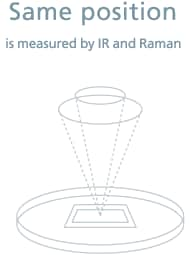
Because samples do not need to be moved, both infrared and Raman spectra can be measured from the same position in an extremely small area. That means information about both organic and inorganic substances can be obtained from the same position, which can significantly improve the accuracy of qualitative analysis. In addition, Shimadzu’s proprietary wide-view camera and microscope camera (for infrared measurements) or objective lens (for Raman measurements) help improve sample observation efficiency. The wide-view camera not only enables observation of large areas up to 10 × 13 mm, but it also supports variable digital zooming. Furthermore, it shares positional information with the microscope camera and objective lenses.
The microscope camera can be used to observe areas as small as 30 × 40 μm, the 50× objective lens to observe areas as small as 15 × 20 μm, and the 100× objective lens to observe extremely small areas as small as 7.5 × 10 μm.
One Software to Measure and Analyze Both FTIR and Raman Spectra
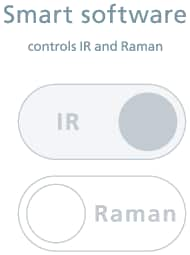
You can easily switch between infrared and Raman measurements with a click. In addition, infrared and Raman spectra can be superimposed and displayed, and various analyses can be performed.
Obtain Organic and Inorganic Information with One Instrument
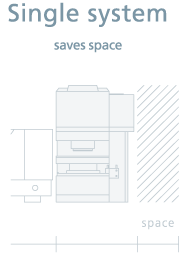
Infrared microscopes can analyze organic substances, but it is difficult to obtain information for many inorganic substances.
On the other hand, Raman microscopes can obtain information about inorganic substances such as titanium oxide and carbon, in addition to organic substances. In contrast, a single AIRsight unit can analyze mixtures of both organic and inorganic substances.
AIRsight Features for Raman Measurements
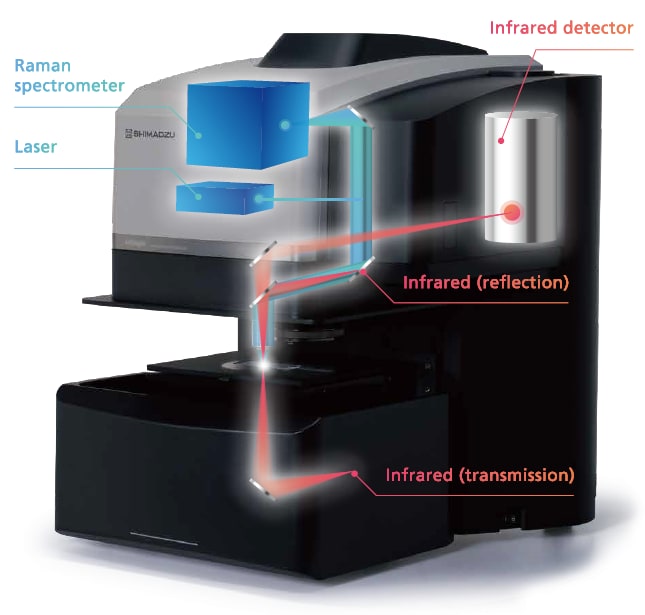
Confocal optical system used
Enables Raman measurements with excellent spatial resolution
Equipped standard with 532 nm and 785 nm lasers
Characteristics of the lasers
532 nm : Light scatters more easily, making it easier to obtain peak intensities.
785 nm : Less affected by fluorescence, making it more suitable for fluorescent samples.
Systems can be equipped with either a 50× or 100× objective lens (or both)
Selectable depending on the target measurement area
Includes XYZ correction for lens switching between infrared and Raman measurements
Enables both infrared and Raman measurements from the same location.
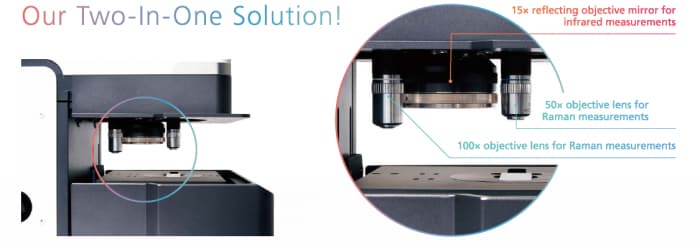
Length Measurement Function
- Infrared Raman
AMsolution software now includes functionality for measuring lengths, including the lengths of objects in infrared Raman microscope images. Also, length measurement results can be output with a single button click. 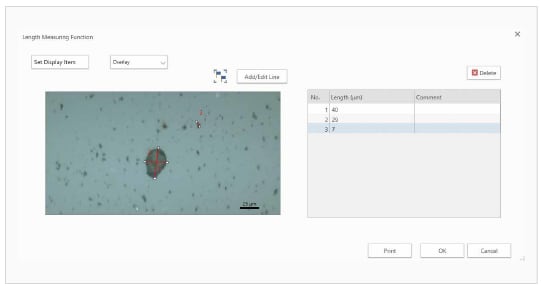
Depth Measurements
- Raman
Enables Analysis in the Depth Direction (Z-Direction)
Raman measurements can measure depth either at a single point or along a line*. If a transparent sample, such as plastic or glass, has a thickness (depth) dimension, the laser light components that can penetrate the sample can be used to measure the sample interior. Even if the sample is colored or cloudy, measurements are generally possible as long as the interior can be observed.
* Measuring depth (at a line) requires an optional high-speed mapping program (P/N 206-36299-41). 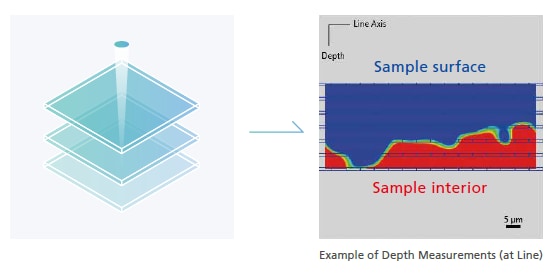
AMsolution
AMsolution includes measurement software (AMsolution Measurement) and analysis software (AMsolution Analysis). The measurement software can control both infrared and Raman measurements via the same window. That means all processes, from image acquisition to measuring infrared and Raman spectra at the same location can be performed smoothly. The analysis software can overlay and search infrared and Raman spectra, create libraries, and so on.
The data measured in infrared mode can be imported to LabSolutions IR and analyzed.*¹
The data measured with AIMsolution, a software program for infrared microscopes, can be analyzed with AMsolution, a software program for AIRsight.
*1 Only with LabSolutions IR Ver. 2.31 or later
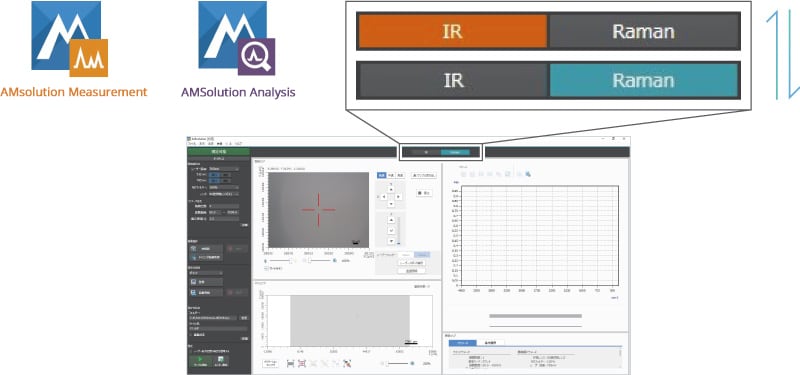
Instrument Validation
A validation program is included as standard with the AMsolution measurement program for inspecting and validating the performance of Shimadzu infrared and Raman microscopes. The infrared mode is validated using a polystyrene film in accordance with the Japanese Pharmacopoeia, US Pharmacopeia, European Pharmacopoeia, and Chinese Pharmacopoeia. The Raman mode is validated using polystyrene pellets to inspect wavenumber accuracy in accordance with the Japanese Pharmacopoeia, US Pharmacopeia, and European Pharmacopoeia. That means analysts can inspect the basic performance of the instrument themselves to ensure that highly reliable data is obtained.
- Infrared Mode Inspection Parameters
- Raman Mode Inspection Parameters
-
- Shape and size of the power spectrum
- Based on the polystyrene film spectrum:
- Resolution
- Wavenumber accuracy
- Wavenumber reproducibility
- Transmittance (or absorbance) reproducibility
- Peak resolution function
- Note:
・ The wavenumber reproducibility is an inspection parameter only required for the Japanese Pharmacopoeia.
・ The Peak resolution function is an inspection parameter only required for the Chinese Pharmacopoeia.
・ The inspection parameter of US Pharmacopeia is only wavenumber accuracy.
-
- Based on the polystyrene pellet spectrum:
- Wavenumber accuracy
- Based on the polystyrene pellet spectrum:
Library Creation Function
The functionality for creating libraries is included as standard with the AMsolution analysis program. Analysts can create their own library by registering the infrared and Raman spectra they acquire. Created libraries can also be used for searches. Registering the materials used in products and the substances used in manufacturing processes and using them as a library can improve the accuracy of searches.
Libraries Containing about 12,000 Spectra
(substances listed in official analysis methods for food additives)
Total of about 12,000 spectra
Wiley Raman spectrum libraries can be added. Wiley offers libraries of spectra from a wide range of compounds, including monomers, polymers, inorganic compounds, and compounds related to biochemistry or forensic chemistry.
Database example
| Product Name | Database Code | Number of Spectra |
|---|---|---|
| Sadtler Controlled & Prescription Drugs 1-2 | RZ, RZ2 | 1,850 |
| Sadtler Flavors & Fragrances | FFR | 600 |
| Sadtler Inorganics | RI | 1,630 |
| Sadtler Polymers & Monomers (Basic) 1 | QR | 1,680 |
| Sadtler Polymers & Processing Chemicals | RA | 495 |
| Sadtler Standards 1-6 | RST1, RST2, RST3, RST4, RST5, RST6 |
6,000 |
| KnowItAll Raman Spectral Library (Annual Subscription) |
- | 25,000 |
Automatic Contaminant Recognition System
- The functionality for automatically recognizing contaminants is included as standard. The analyst simply clicks one button for the software to automatically recognize contaminants. Two types are available for the infrared mode: the standard type or the micro type for extremely small areas, which can be selected based on the purpose of analysis. Samples can either be measured with the automatically selected measurement positions left unchanged or the analyst can add or delete measurement positions. A sample image is automatically saved for each measured spectrum. That makes it easy to confirm the sample or measurement positions later.
